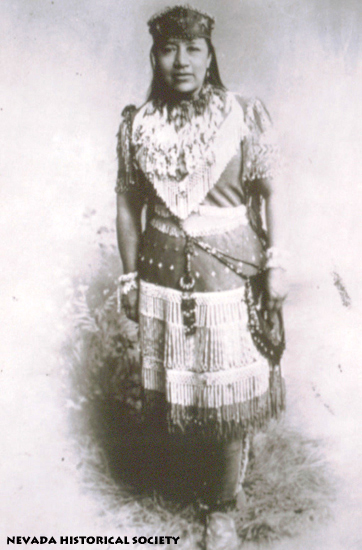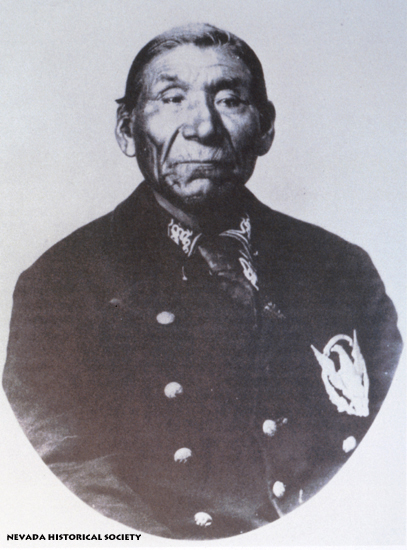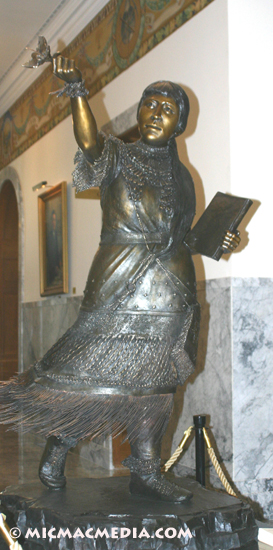|
Tahoe Nugget #108:
Sarah Winnemucca: Desert Princess
March 27, 2007
Sarah Winnemucca should be as famous as the iconic Indian maidens, Pocahontas and Sakakawea, whose Disney-designed images have been embraced by millions of American children (and their parents), but the country
will probably have to wait until a major movie company produces a film (probably animation) about Sarah's life and achievements before many people learn her compelling story.
The Northern Paiutes were a
generally peaceful, loose-knit tribe led by Chief Truckee. The tribe inhabited a large region east of the central Sierra crest, which included Lake Tahoe, the length of the Truckee River, and from northeastern
California into southeastern Oregon.
One of Truckee's sons, Winnemucca, was a major chief in his own right. In 1844, Winnemucca's wife gave birth to their fourth child, a girl named Thocmetony (Shell
Flower), later anglicized to Sarah. When Sarah was a baby, her maternal grandfather, Truckee, was away in California with General John Frémont's army fighting alongside the Americans in the Mexican-American War.
At 13, Sarah moved to Genoa, Nevada, to live and work in the household of Major William Ormsby. (Ormsby was later killed by Paiute warriors in the Pyramid Lake War of 1860.) While living with the Ormsby
family, Sarah taught herself to read and write English.
During the 1860s, the US army adopted the "Humboldt Code," which mandated that soldiers "kill and lay waste everything pertaining to the tribes,
whenever found; no trials, no prisoners, no red tape." In one massacre, Sarah's sister, mother and little brother were killed. At the time, Sarah was working as an interpreter for the US government. She began
writing letters describing her people's decimation to the Indian Commissioner and politicians in Washington, D.C. They were widely circulated and drew much sympathy from the general public.
Sarah's
reputation as a passionate and articulate spokesperson for the Paiutes gained her both friends and enemies. She was attractive, headstrong and proud, qualities that made her a lightning rod for trouble. Newspapers
reported her clashes with both men and women, including one incident where Sarah knifed a man who had touched her inappropriately.
In 1870, she married First Lieutenant Edward C. Bartlett, a handsome officer
but an irresponsible drunkard. While Sarah earned a living working as an interpreter and educator, Bartlett spent his time drinking and gambling her money away. Their relationship was short-lived, as Bartlett soon
resigned from the army and left town, although he continued to write Sarah for money. Sarah married three more times, but always seemed to end up with losers.
Sarah traveled extensively on the East Coast,
giving hundreds of impassioned lectures in New York, Philadelphia and Baltimore. Audiences cheered and wept, but the government did little to help the Paiutes. She met President Hayes, but he too failed to act on
his words of support.
Eventually the Paiutes succeeded in establishing the first Indian-initiated school near Lovelock, Nevada, where Sarah taught for years. In 1883 she wrote an autobiography, Life Among the Paiutes: Their Wrongs and Claims,
the first book written by an Indian woman. The book, written in English, was also the first by any Indian west of the Rockies and is a unique portrait of America by an Indian woman from her own point of
view.
When Sarah Winnemucca died in October 1891, the New York Times' wrote, "She was the only Indian who ever took any prominent part in settling the Indian question, and as such her memory should be respected. She did our government great service, and she willingly helped the white settlers and her own people to live peaceably together. The name Thocmetony should have a place beside the name of Pocahontas in the history of our country."
In 2005, a statue of Sarah Winnemucca was placed in the National Statuary Hall, Washington, D.C. It joined Sakakawea of North Dakota as one of only two sculptures depicting Native American women in the Hall. A replica can also be viewed in the lobby of Nevada's State Capitol building in Carson City.
Photo #1: Sarah Winnemucca in ceremonial dress
Photo #2: Pyramid Lake is an important feature in Northern Paiute's homeland
Photo #3: Chief Winnemucca
Photo #4: According to the sculptor, Benjamin Victor, the book in Sarah's left hand is not only a reference to the book she wrote, it is also a symbol for education, knowledge and morality. The flower in her right hand is a literal reference to her Paiute name and represents Sarah's highest esteem for her native culture. Statue in Carson City.




|






